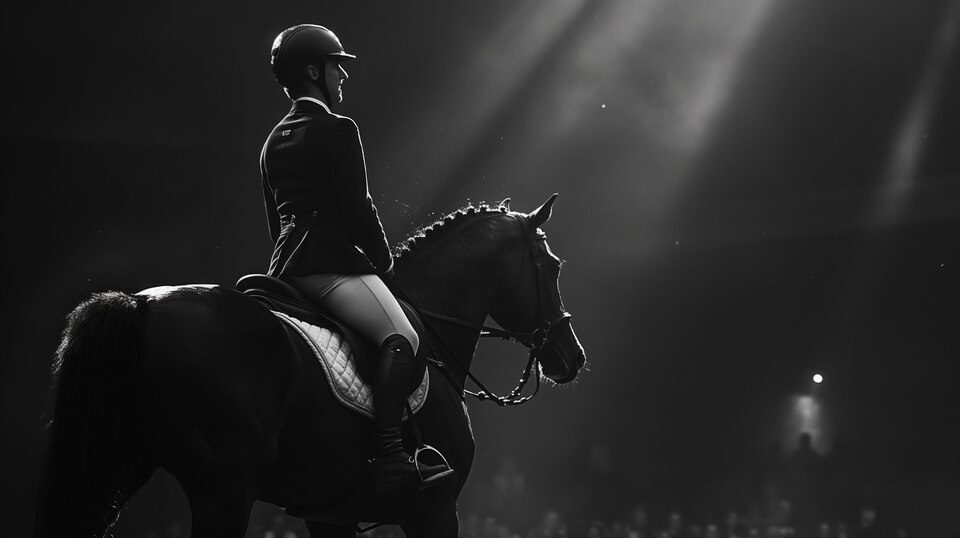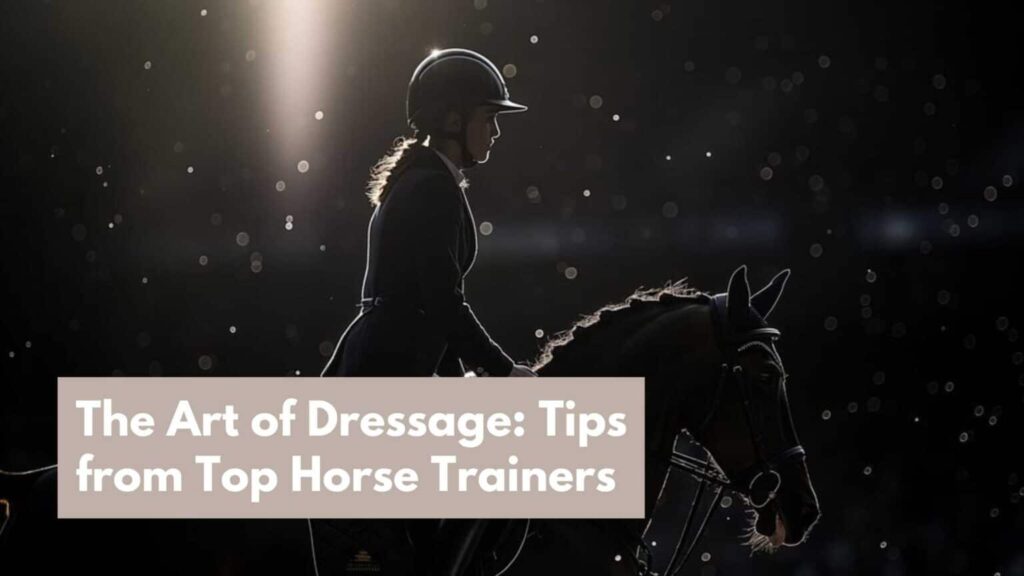Dressage, often called the “ballet of horseback riding,” is a sport that transcends the boundaries of simple horse training and enters the realm of art. The elegance, precision, and harmony between rider and horse make dressage one of the most beautiful and technically challenging equestrian disciplines. But what is the secret behind the seamless fluidity we witness in world-class dressage competitions? It’s not just the horse’s skill but the mastery of riders who train for years to perfect their craft. This blog will delve into The Art of Dressage and uncover tips from top horse trainers to elevate your performance.

Understanding the Art of Dressage
Understanding The Art of Dressage itself is crucial before going into helpful advice. “Dressage” is derived from the verb “dresser,” which in French means “to train.” Fundamentally, dressage is about enhancing a horse’s innate athleticism and capacity to carry out a variety of intricate manoeuvres in response to the rider’s subtle inputs. These motions, called “tests,” consist of piaffes (a place-holding, high-stepping trot), passages (a graceful, suspended trot), and pirouettes (turns performed on the haunches). The horse’s strength, Balance, and agility are all on display in each action.
A rider must develop a strong bond and earn the trust of their horse to succeed in The Art of Dressage. Creating an effortless performance—as though the horse and rider are one unit moving in perfect harmony—is the ultimate goal.
Tips from Top Horse Trainers to Master Dressage
Now that we’ve grasped the essence of dressage, let’s explore some Tips from Top Horse Trainers that can help you elevate your game and deepen your understanding of The Art of Dressage. These insights focus on the technical and mental aspects of training, ensuring that you and your horse are prepared to perform at your best.
1. Patience and Consistency are Key
The first thing you learn from The Art of Dressage is that it takes time and patience. Proficient trainers frequently stress the need for gradual and steady improvement. Although it can be tempting to breeze through training, the fundamentals must be sound. One of the most significant pieces of advice from professional horse trainers is always to emphasize the value of developing a solid foundation of skills before advancing to more complex manoeuvres.
It is not possible to impose a result in dressage. Teaching a horse and rider the essential abilities takes time. The secret to realizing potential is patience, according to famous dressage trainer Carl Hester.
Tip: Ensure that your horse is comfortable with the basics before you move on. Practice transitions, straightness, and simple changes until they are executed smoothly. This patience will pay off as you move to more complex exercises.
2. Develop an Independent Seat
In The Art of Dressage, riding with an independent seat is essential. To ride without depending on the reins for control or Balance is to do this. Instead, interact with your horse through your legs and seat; reserve the reins for more nuanced cues and modest assistance. Tips from Top Horse Trainers emphasize that the horse should react to the rider’s entire body, not just their hands.
Leading dressage instructor Charlotte Dujardin highlights the significance of seat control, saying, “Our most potent tool is the rider’s seat. A balanced rider may use small movements to communicate with their horse successfully.”
Tip: Focus on improving your seat by practising without stirrups. This will help you develop a deeper seat and more Balance in the saddle, enabling you to communicate more clearly with your horse.
3. Perfect the Basics
Understanding the fundamentals is the foundation of The Art of Dressage. Expert instructors agree that perfect performance of foundational exercises, like transitions, straightness, and lateral work, lays the groundwork for more complex dressage methods.
Trainers like Steffen Peters emphasize that “until the fundamentals are strong, you cannot progress to advanced movements.” How can you ever hope to execute a piaffe or passage if you cannot make a flawless circle or a seamless trot-to-canter transition?
Tip: Pay close attention to transitions and ensure your horse reacts smoothly and instantly. Work on making transitions with balanced, fluid movements to improve your horse’s responsiveness.
4. Focus on Suppleness and Flexibility
In The Art of Dressage, the horse’s capacity to move freely through its body is referred to as suppleness. The horse needs this flexibility to execute the complex movements needed for dressage. Tips from Top Horse Trainers frequently stress the value of lateral movements to improve suppleness, like shoulder-in and leg yielding.
Tip: To increase your horse’s flexibility, include exercises like loops and serpentines. This will give them more freedom to move around their bodies.
5. Use Transitions to Build Balance
A vital component of The Art of Dressage is Balance. A horse with good Balance moves smoothly and effortlessly. Adding transitions to your everyday workout is one of the best strategies to develop Balance. This covers changes in gaits (walk, trot, canter) and gaits themselves (collected, working, and extended).
According to renowned trainer Carl Hester, transitions are the cornerstone of Balance in dressage. By having your horse practice upward and downward transitions, you can assist them in becoming more balanced and engaging their hindquarters.
Tip: During your tutoring sessions, practice transitions frequently, emphasizing gradual, well-balanced shifts. Your horse will become more receptive to your cues and more balanced.
6. Prioritize Mental Connection with Your Horse
The mental bond between horse and rider is one of the distinctive features of The Art of Dressage. Prominent trainers stress that success depends on this relationship. A horse is more likely to behave readily and enthusiastically if it feels connected to its rider.
The goal of massage is harmony. Olympic medallist Isabell Werth states, “The rider must understand the horse’s mind as much as the horse’s body.” “Mental preparation is equally as vital as physical training.”
Tip: Make time to bond with your horse outside of training. Grooming, hand-walking, and groundwork exercises can improve communication in the saddle, helping develop trust and strengthen your partnership.
7. Keep Your Training Sessions Short and Focused
Prominent equestrian instructors know that, like people, horses have a finite amount of attention. Training sessions should be brief yet efficient in The Art of Dressage. Choose quality over quantity so as not to overburden or irritate your horse.
Leading trainer Carl Hester says, “The horse should enjoy dressage training.“ Avoid making too many requests in one sitting. Give your horse praise for even the tiniest accomplishments.
Tip: Plan your lessons thoroughly and focus on one or two issues at a time. End on a good note to leave your horse feeling successful and eager to go back to work the next day.
8. Understand the Importance of Rider Fitness
Concentrating only on the horse’s level of fitness is simple, but The Art of Dressage also requires the rider to be in top physical condition. Dressage requires endurance, flexibility, and core strength. Many elite trainers advise riders to focus on their fitness to increase their riding abilities.
Charlotte Dujardin emphasizes the significance of rider fitness: “You must be at your best if you want your horse to perform at its best.“ A fit and powerful rider can improve their and their horse’s performance.
Tip: Include non-equine exercise regimens like yoga or Pilates in your weekly schedule. These exercises will make you a more proficient rider and increase your general Balance, flexibility, and core strength.
Mastering the Art of Dressage
The Art of Dressage is a lifetime endeavour that combines skill, patience, and the bond between the horse and the rider. You can become an expert in this lovely equestrian discipline with commitment and the help of Tips from Top Horse Trainers. Prioritize developing a solid base, flexibility, Balance, and connection, and constantly aim for harmony in every movement. You’ll strengthen your relationship with your horse and advance toward the artistic excellence that dressage is renowned for by implementing this professional training advice into your training.
Remember that creating a masterpiece of grace, beauty, and harmony with your horse is as important as completing exercises as you continue your journey through the art of dressage.

